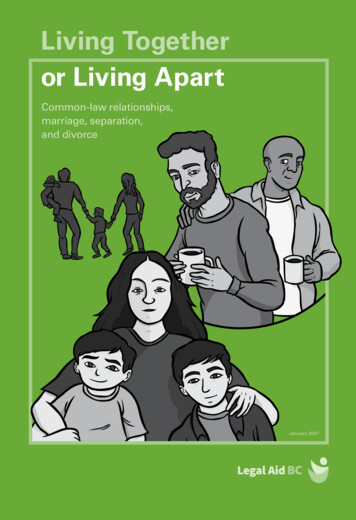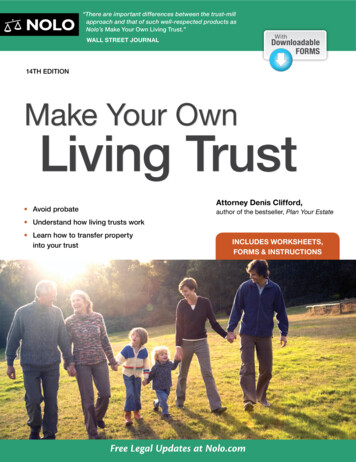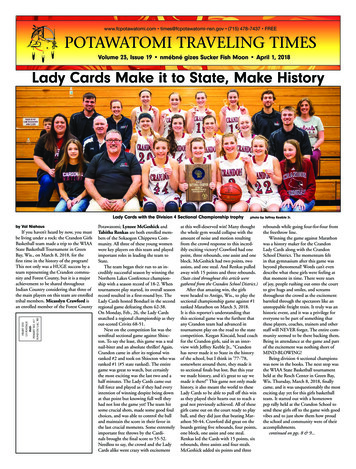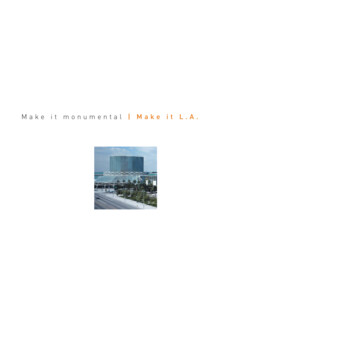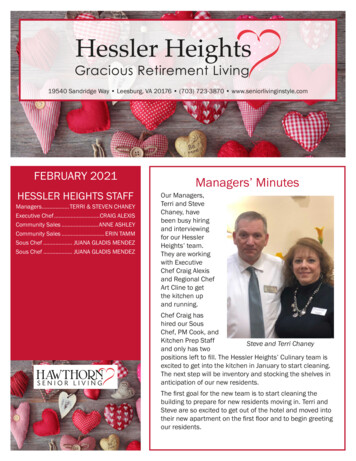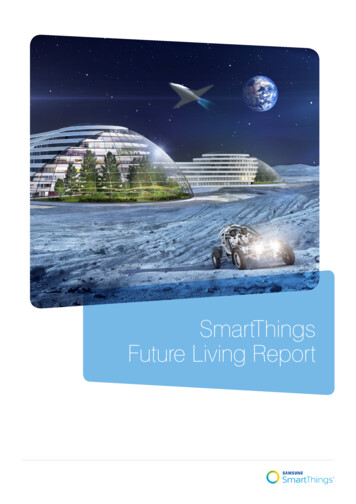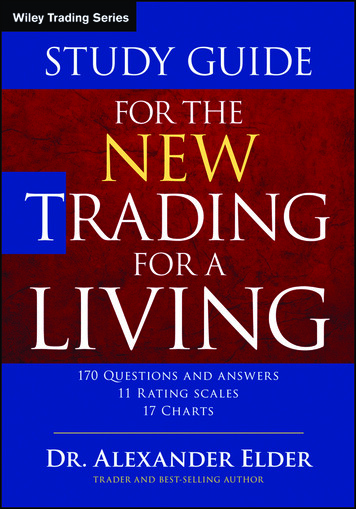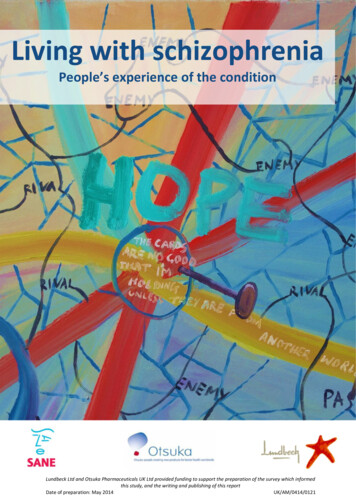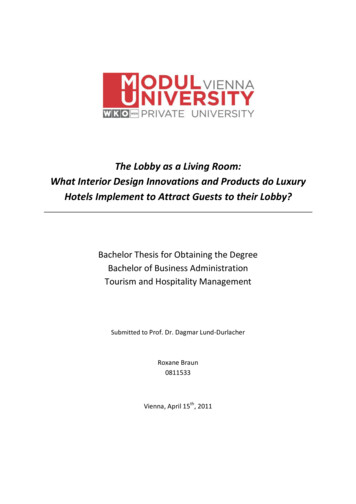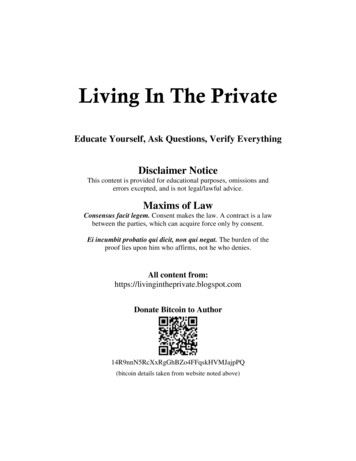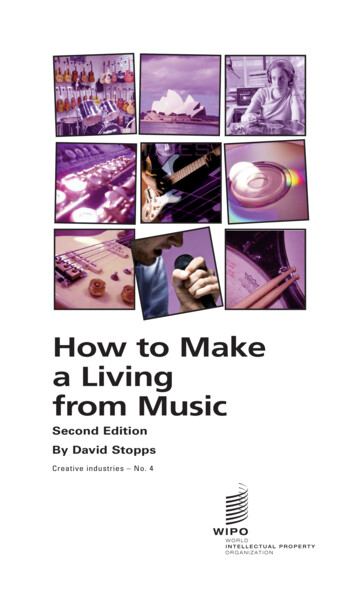
Transcription
How to Makea Livingfrom MusicSecond EditionBy David StoppsCreative industries – No. 4
How to Make a Living from Music
How to Make a Living from Music3TABLE OF CONTENTSPREFACE7INTRODUCTION9DEFINITIONS16CHAPTER 119WHERE THE MONEY COMES FROM1.iAuthors1.iiPerformers191919CHAPTER 222BUILDING A TEAM2.iAuthors2.iiPerformers222224CHAPTER 326COPYRIGHT AND RELATED RIGHTS3.iRights for Authors3.iiRights for Performers3.iiiRights for Phonogram Producers3.ivLicensing and Assignment3.vExclusive Rights and Rights of Remuneration3.viMaking Available3.vii Limitations and Exceptions and the Three-step Test3.viii Fair Use and Fair Dealing3.ixMoral Rights3.xNational Treatment, Term of Protection and the Public Domain3.xiCopyright Registration3.xii Trademarks3.xiii Two Copyright Laws that support Authors and Performers3.xiv Creative Commons3.xv Copyright Infringement and How to Stop It3.xvi Carrot, Stick and Education3.xvii Creative Heritage Project263031323233343536373840404142434448
How to Make a Living from Music4CHAPTER 4COLLECTIVE MANAGEMENT AND COLLECTION MANAGEMENTORGANIZATIONS (CMOs)4.iWhy is Collective Management Necessary and what is its History?4.iiThe Importance of Correct Registration of Works, Performances andRecordings4.iiiFunctions and Governance of Collective Management Organizations4.ivCollective Management Organizations Databases and the Conceptof a Global Repertoire Database (GRD)4.vCollective Management Organizations for Authors4.viAuthors’ Public Performance Collective Management Organizations4.vii Authors’ Mechanical Income and Mechanical Copyright CollectiveManagement Organizations4.viii Related Rights Public Performance in Sound Recordings CollectiveManagement Organizations4.ixFeatured and Non-Featured Performers4.xHome Copying Levies494949515253555558606566CHAPTER 568A SHORT HISTORY OF THE MUSIC INDUSTRY68CHAPTER 672ARTIST DEVELOPMENT AND ARTIST MANAGEMENTChoosing a NameArtist ManagementArtists seeking ManagementA good manager should:Managers Seeking ArtistsShort-Term Letter of AgreementLong-Form Artist Management AgreementsThe Importance of Independent Legal AdviceVerbal AgreementsLegal Limitations and Implied Terms for Verbal ContractsAlternative AgreementsProduction and Publishing Agreements as Alternatives to R 785BAND AGREEMENTSLegal StatusIssues covered by Band AgreementsDispute Resolution8585868881
How to Make a Living from Music5CHAPTER 889STARTING A RECORD LABEL – BECOMING AN INDEPENDENTPHONOGRAM PRODUCER89CHAPTER 993ARTIST & LABEL FINANCING – CROWD SOURCING93CHAPTER 1097SIGNING TO A PHONOGRAM PRODUCERAdvances and Recoupment360 Degree AgreementsWebsite and Fan Database Ownership97102103103CHAPTER 11104STUDIO PRODUCER AGREEMENTS, RECORDING, SAMPLING &MASTERING104CHAPTER 12107MUSIC PUBLISHING107CHAPTER 13112MUSIC IN FILM, TV, ADVERTISING AND VIDEO GAMESMusic in FilmsMusic in TelevisionMusic in AdvertisingMusic In Video Computer GamesLibrary or Production MusicCommissioned MusicTips for placing music in Film, TV, Advertising and Video Games112113116117117118119119CHAPTER 14122LIVE WORK, TOURING AND MERCHANDISINGGetting Started as a Live ArtistSound and LightingHow to Get Live WorkStreet Performances and BuskingThe Next StageBooking AgentsTour ManagersBuilding a Touring TeamVisas and Work PermitsFreight Agents, Shipping and Carnets122123123124126128128130130131131
How to Make a Living from Music6Travel and Hotel ArrangementsInsurance and Force MajeureSecurityAccountingPer DiemsFestivals and Conferences132133136136137139CHAPTER 15143Merchandising143CHAPTER 16147SPONSORSHIP AND BRANDING147CHAPTER 17152THE DIGITAL REVOLUTIONA Short HistoryDigital Rights Management and Technical Protection MeasuresDigital Marketing and DistributionBuilding a Fan BaseSocial NetworkingFacebookEnsuring Content Gets SeenTwitterYouTubeCase study – The Young TigersThe Future152152155157166170171175179182186190ANNEX A195DEFINITIONS AND INDEX195ANNEX B220EXAMPLE OF A SHORT-TERM LETTER OF ENGAGEMENT220ANNEX C223EXAMPLE OF A LONG-FORM ARTIST MANAGEMENT AGREEMENTACKNOWLEDGEMENTSFURTHER READINGBooksInformation and NetworkingConferencesABOUT THE AUTHOR223237239239241242243
How to Make a Living from Music7PREFACEThe World Intellectual Property Organization (WIPO) is pleased to present thissecond edition of the Creative Industries book How to Make a Living from Music.The book is designed for musicians and music professionals who wish to honetheir knowledge of the music business. It offers practical information to helpauthors and performers appreciate the importance of proper management of theirintellectual property rights, in addition to providing instructive advice on how tobuild a successful career in music by generating income from musical talent.The book provides useful definitions of grassroots concepts and identifies thebasic income streams for authors and performers. Special attention is given tocopyright and related rights, and their particular application in the music context.The book underscores the importance of artist development and management,and provides guidelines on establishing fair arrangements for benefit sharingresulting from songwriting and performances.How to Make a Living from Music is written, first and foremost, as a practical toolfor creators in the world of music who are still in the process of establishingthemselves in the market. Hence it offers a style that is designed to reach out toa broad audience. Secondly, the publication explores the interface between thecreative process and all the necessary management arrangements which need tobe in place from the moment of creating the music material until the moment itreaches the audience, thus providing valuable insights on synergies betweencreative and entrepreneurial approaches. Thirdly, it looks into the importance ofusing the enabling infrastructure such as collective management organizations,registration systems and available compensation schemes. The value of thepresented material is reinforced by the detailed annexes which can guide musicprofessionals through the practical complexities of the music business.
How to Make a Living from Music8This book is intended as a tool for musical authors and performers both indeveloped and developing countries. Many international examples have beenincluded, making it a useful instrument for creators worldwide. The content is notmeant to be used as a substitute for professional advice on specific legal issues.How to Make a Living from Music was commissioned by WIPO and written byDavid Stopps,1 a seasoned music manager with vast international experience.The author is not an academic or a lawyer. Rather, he is a working music businessartist manager, event promoter and entrepreneur with over 40 years’ experiencein dealing with copyright and music monetization issues at the music industry’scoalface. This book is therefore written from the point of view of a practitionerand tends to take a pragmatic, practical approach, rather than a theoretical oracademic one. The views expressed in the book are those of the author and donot necessarily reflect those of the Organization.
How to Make a Living from Music9INTRODUCTIONThis is a very exciting time for music artists. A music artist is always a performer(someone who sings and/or plays a musical instrument) and is often also a musicauthor (a composer, songwriter, lyricist or arranger). Never before in the history ofthe world music business have there been so many opportunities for authors andperformers to get their music heard and sold on a global level.So much has happened since the first edition of this book. We have seen theemergence of Twitter as a major marketing tool for music, and continued expansionand innovation from Google, Apple, Facebook and Amazon (often collectivelyreferred to as GAFA). We have also seen Myspace falling into decline after it waspurchased by News Corp and then seemingly revived in 2013 under the stewardshipof Justin Timberlake. Cloud computing and storage are emerging as the next majorphase in the development of digital music services, as we move from a copyeconomy (CDs and downloads) to an access economy (streaming). Artists arediscovering that ‘data is the new oil’ as they constantly find ways to grow adatabase of fans which will be key to their success in the new digital ecosystem, anecosystem increasingly being driven by artists and artist managers. More and moremusic is becoming social, with sharing and recommendations being at the heart ofmusic discovery and digital music marketing. Whereas in previous times fans wereregarded as consumers, they are now a vital and active part of every businessmodel.Google’s YouTube has become the world’s biggest music discovery website, whichhas increasingly resulted in music moving from audio-only to an audio-visual format.Korean artist PSY’s ‘Gangnam Style’ video received over one billion views onYouTube in 2012, making it the most viewed video in YouTube history. The audioversion of the track was successful, but not as successful as the video, whichshows that fans want the full multimedia experience. Meanwhile Lady Gaga has
How to Make a Living from Music10created her own social network, ‘Little Monsters’, created by Backplane, which usesFacebook as a feeder. More and more artists and managers are taking the DIY (Do ItYourself) route, but that cannot function in a vacuum. Fans expect artists to nurturetheir digital presence by constantly updating their website and their social mediaartist pages, and by providing regular and interesting tweets and Facebook posts.Real-time analytics are proving invaluable, as they can reveal exactly what type offans an artist has and, more importantly, where they live, which greatly assistssuccessful tour planning. In the digital services landscape we are increasingly seeing‘freemium’ offerings such as SoundCloud, Dropbox and Reverbnation, which providethe basic version free to download and use, whereas more advanced features orincreased capacity have to be paid for. We are seeing traditional financial advancesfrom third-party phonogram producers (record companies) becoming more scarce,and financial crowd-sourcing directly from fans providing an alternative source offinance for artist projects. Where recording agreements are on offer, phonogramproducers are increasingly demanding a 360 degree contract wherein they willreceive income from live work, merchandising, branding and sometimes publishingin addition to recording income. When it comes to recording, recording hardware isbecoming ever more sophisticated and less and less expensive.Telecoms are also getting involved with music content and are developing their ownmusic stores and services in some countries. New innovative digital services areconstantly being launched, but innovation in the coming years will be driven by thecompetition between Apple’s iOS system and Google’s Android in the mobileecosystem. Anyone doubting the true value of music should consider that Applebecame the world’s largest corporation in 2011, with music being one of the maindrivers of that achievement. When Steve Jobs launched iTunes and the iTunes musicstore, he was not focused on selling music but rather on using music to sell iPods andcomputers. iTunes enabled Apple to take a massive market share in the portable digitalmusic player market and by association the personal computer market. Apple laterexpanded the same music storage ability from the iPod to the iPhone and the iPad.As the Internet is geographically neutral, where an artist is based has become farless important. In previous times, it was often advisable for an author or performerto move to one of the world’s major music business centers, such as Los Angeles,Paris, Hamburg, London, New York or Nashville. With the advent of the Internet, that
How to Make a Living from Music11is far less important. If an artist can create and record great music, all that is neededis a table, a chair, a computer and a broadband connection and he/she is in businesson a global level. Provided an artist can create a good website and have an activepresence on the key social networking sites, all the world’s markets are at theirfingertips, no matter where they live.Philosopher and composer Friedrich Nietzsche famously said ‘Without music lifewould be a mistake’. How right he was. The whole world is mad on music. Even inthe very poorest countries, singing, dancing and making music are an important partof daily life. In the developed world, interest in music is increasing all the timemainly due to the ease of access that the Internet and the digital ecosystem areproviding. Music is deeply embedded in the culture of every country. In the past, theonly music that could easily be purchased was that stocked by record stores. Due tothe limitations of the size of any particular record store, the stock carriedrepresented only a small fraction of the music that had been recorded worldwide.The Internet has changed all that. The diversity of music now available means thatanyone with an Internet connection has access to a record shop measuring tenkilometers by ten kilometers, and it’s always expanding.Age is also becoming a significant factor. In the developed world, older people areregarded as digital immigrants whereas younger people are digital natives.Developed countries are seeing a significant reduction in youth crime as computers,smartphones, social networking and video games take away the youth boredomfactor.This book is designed to identify and explain the basic income streams that exist inthe worldwide music industry for musical authors and performers (and also forphonogram producers, publishers and anyone involved in the music industry). It isintended primarily to reveal to authors and performers the most effective way togenerate income from their talent and endeavors, and the best way to achieve fairarrangements for the exploitation of
Library or Production Music 118 Commissioned Music 119 Tips for placing music in Film, TV, Advertising and Video Games 119 CHAPTER 14 122 LIVE WORK, TOURING AND MERCHANDISING 122 Getting Started as a Live Artist 123 Sound and Lighting 123 How to Get Live Work 124 Street Performances and Busking 126 The Next Stage 128 Booking Agents 128 Tour Managers 130 Building a Touring Team
